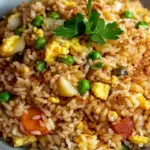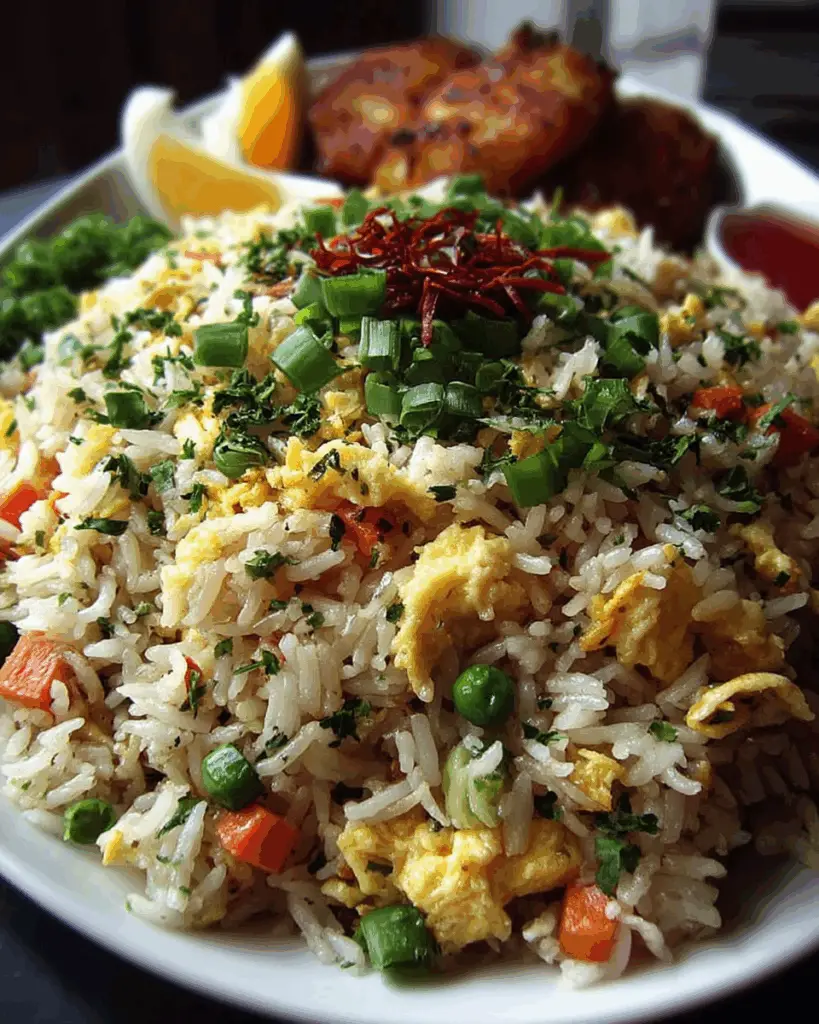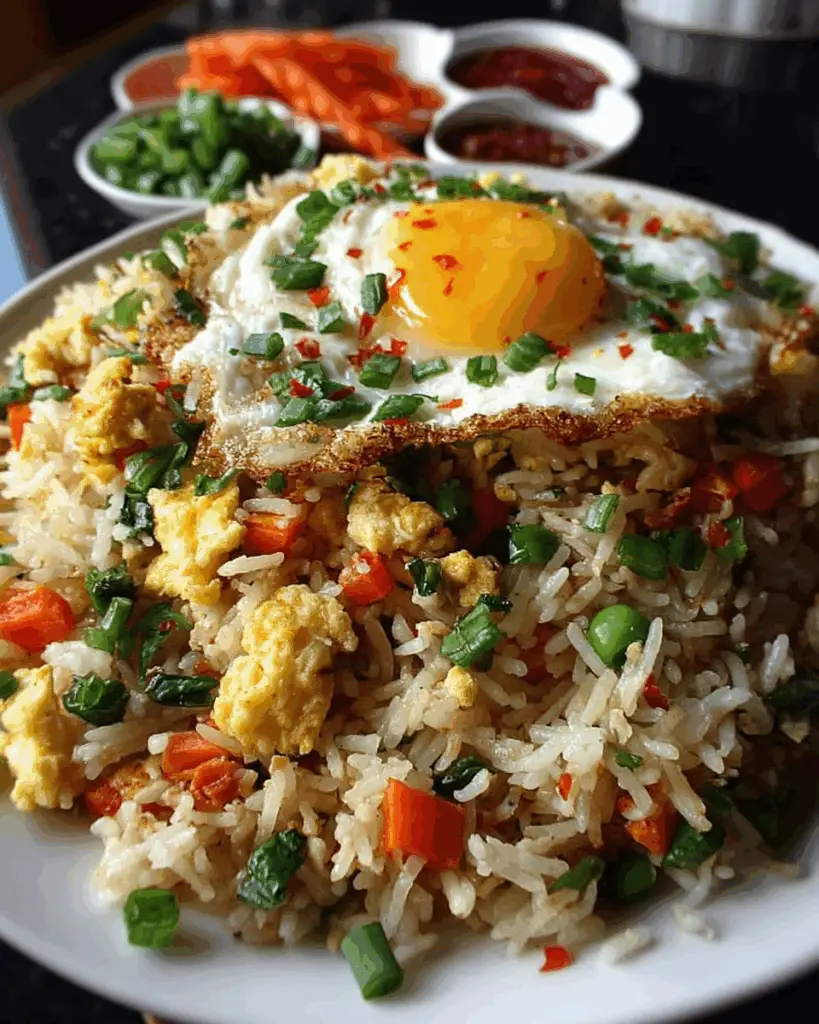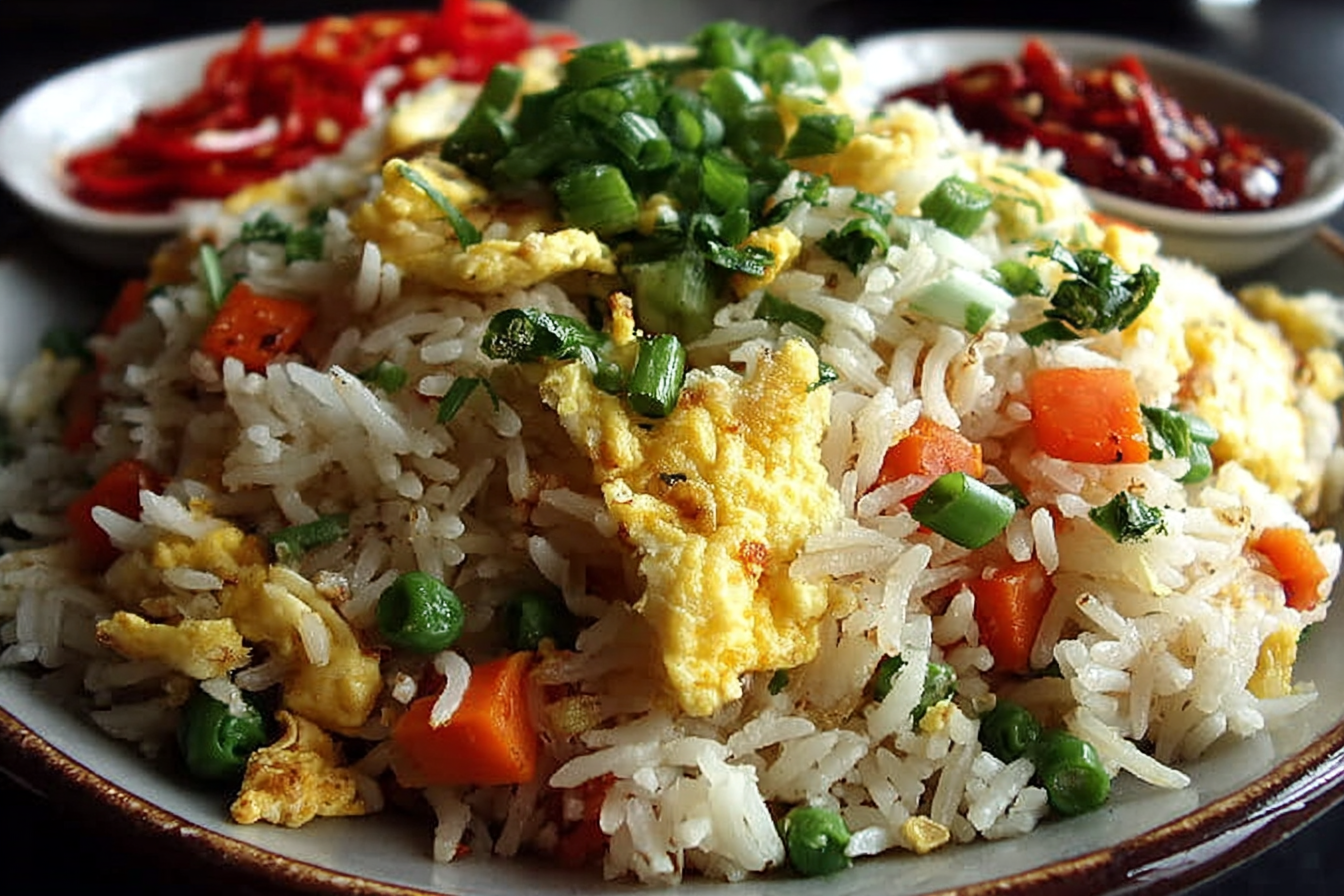Egg Fried Rice is one of those classic dishes that never goes out of style—easy to make, incredibly flavorful, and endlessly customizable. Whether you’re using up leftover rice or craving a quick, satisfying dinner, this simple stir-fry transforms basic ingredients into a savory, golden bowl of comfort. Made with scrambled eggs, crisp veggies, and perfectly seasoned rice, it’s a takeout favorite that tastes even better at home.
Table of Contents
Table of Contents
What Gives Chinese Egg Fried Rice Its Signature Flavor?
The rich, savory flavor of authentic egg fried rice comes from a simple but powerful trio: aromatics, umami seasoning, and high heat. These elements work together to create the bold taste you expect from Chinese-style fried rice.
Key Flavor Elements:
- Soy Sauce: Adds deep umami and saltiness—use light soy sauce for a cleaner, balanced taste.
- Toasted Sesame Oil: Just a drizzle enhances aroma and delivers nutty depth.
- Aromatics: Diced onion and scallions sautéed at high heat bring sweetness and complexity.
- Chinese Five-Spice Powder: A warm blend of star anise, cloves, cinnamon, Sichuan peppercorn, and fennel that gives this recipe a subtle, distinctive edge.
- Wok Hei: That elusive “breath of the wok” — a slight smokiness you get when stir-frying over high heat.
Pro Tip: Use day-old jasmine rice for the best texture—it stays fluffy and lightly chewy instead of mushy.
Do You Add Eggs Before or After in Fried Rice?
For perfect egg fried rice, the timing of when you cook the eggs makes a big difference in texture and taste.
Best Practice: Cook Eggs First, Then Set Aside
The most reliable method is to scramble the eggs separately at the start, then remove them from the pan before stir-frying the vegetables and rice. This keeps the eggs soft, fluffy, and full of flavor without getting lost or overcooked in the mix.
Why This Works Well:
- The eggs maintain their texture instead of becoming rubbery
- It’s easier to mix them evenly into the rice later
- You avoid accidentally overcooking them during high-heat stir-frying
Some advanced cooks stir the eggs directly into the rice, but if you’re aiming for well-defined flavor and soft curds, cooking them separately first is your best bet.
Ready to master it from scratch? Let’s dive into the full Egg Fried Rice recipe.
Print
Egg Fried Rice
- Total Time: 20 minutes
- Yield: 1 servings
- Diet: Vegetarian
Description
I always recommend using day-old rice when making fried rice — it’s less moist, which helps you get that perfect texture without turning everything mushy. If you’re cooking the rice fresh, just be sure to let it cool completely before it hits the pan. Want to level up the flavor? Try adding a drizzle of my homemade teriyaki or hoisin sauce. And if you’re a visual learner, don’t worry — there’s a step-by-step video waiting for you at the bottom of the recipe!
Ingredients
4 large eggs
3 tablespoons peanut, vegetable, or olive oil, divided (see note 1)
1 cup diced onion, about 1 small onion (see note 2)
1 1/2 to 2 cups diced mixed vegetables, such as bell pepper, carrots, zucchini, etc. (see note 3)
1/2 cup sliced scallions, white and green parts divided (see note 4)
pinch of salt
4 cups cooked overnight jasmine rice, see note 5
2 1/2 tablespoons soy sauce, use tamari if gluten free
1/2 teaspoon five-spice powder
dash of ground white pepper, optional
1 to 2 teaspoons toasted sesame oil
Instructions
Crack the eggs into a small bowl and beat them together.
Heat a skillet with 1 tablespoon of the oil over medium-high heat. Once the pan is hot, add the beaten eggs and scramble them for about a minute. Transfer the eggs to a dish and turn off the heat.
Drizzle the remaining 2 tablespoons of oil into a wok over high heat. Add the onions and cook them for about 1 to 2 minutes, stirring constantly. Add the mixed vegetables and white parts of the scallions and cook for 2 minutes. Season the vegetables with a pinch of salt.
Add the cooked rice into the pan or wok and cook for several minutes, until the rice is heated through. If there are large clumps of rice, break them apart with the back of your spatula.
Add the soy sauce, five-spice powder, dash of white pepper (if using) and sesame oil and stir to distribute the seasonings. (See note 6) Add the scrambled eggs and stir to mix again. Garnish with remaining sliced scallions. Serve immediately.
Notes
Peanut oil will give the fried rice a nice light fragrance. I know that olive oil is not traditionally used in Chinese cooking, but you can’t really detect the flavor of the olive oil in this recipe.
It doesn’t matter what color onion you use. White, yellow, sweet, or red onions work. If you don’t have onions, you can use shallots.
You can use whatever vegetables you want for this recipe. Corn, bell peppers, carrots, green beans, zucchini, and peas are all great options for this fried rice. The exact amount of vegetables you use is up to you. Keep in mind that the more vegetables you use, the more moisture you’ll likely introduce to the wok as you cook the fried rice. This can lead to soggy fried rice, especially if there is a lot of crowding in the wok (or sauté pan). I have found 2 cups of diced vegetables to be sufficient.
I like to reserve some of the dark green parts of the scallions for garnish.
If you are looking for a basic recipe for cooking jasmine rice, refer to my guide on how to cook jasmine rice. You can also use a fork to loosen the rice before you add it to the wok. This will make it easier for you to break apart any large clumps of rice.
If you want to add more flavor to the fried rice, mix it 1 tablespoon of my teriyaki sauce or store-bought hoisin sauce.
I have updated this recipe as of August 17, 2020 to add more vegetables and slightly more seasoning to the fried rice.
- Prep Time: 10 mins
- Cook Time: 10 minutes
- Category: Main Dish
- Method: Stir-fry
- Cuisine: asian
Nutrition
- Serving Size: 1 serving
- Calories: 425kcal
- Sugar: 3g
- Sodium: 423mg
- Fat: 17g
- Saturated Fat: 3.2g
- Unsaturated Fat: 1.7g
- Trans Fat: 16.7g
- Carbohydrates: 55.6g
- Fiber: 4g
- Protein: 13.4g
- Cholesterol: 186mg
Egg Fried Rice Recipe (Easy Step-by-Step)
This easy, flavor-packed egg fried rice recipe uses pantry staples and fresh vegetables to deliver better-than-takeout results at home. Let’s get cooking!
Ingredients
- 4 large eggs
- 3 tablespoons oil (peanut, vegetable, or olive oil – divided)
- 1 cup diced onion (about 1 small)
- 1½ to 2 cups diced mixed vegetables (e.g., bell pepper, carrots, zucchini)
- ½ cup sliced scallions (white and green parts separated)
- Pinch of salt, to taste
- 4 cups cooked jasmine rice (cold, ideally day-old)
- 2½ tablespoons soy sauce (or tamari for gluten-free)
- ½ teaspoon Chinese five-spice powder
- Dash of ground white pepper (optional)
- 1–2 teaspoons toasted sesame oil, for flavor
Instructions
- Scramble the Eggs:
Crack the eggs into a bowl and beat them. Heat 1 tablespoon oil in a skillet over medium-high heat. Once hot, pour in the eggs and scramble for about 1 minute until just set. Transfer to a plate and set aside. - Sauté Aromatics & Veggies:
Heat the remaining 2 tablespoons oil in a wok or large skillet over high heat. Add the diced onion and cook for 1–2 minutes, stirring frequently. Add the mixed vegetables and the white parts of the scallions. Stir-fry for another 2 minutes. Sprinkle a pinch of salt to enhance flavor. - Add the Rice:
Break apart any clumps in your chilled rice and stir it into the wok. Cook for 2–3 minutes, allowing the rice to heat evenly and soak up the oil and aromatics. - Season:
Pour in the soy sauce, sprinkle over the five-spice powder, and add a dash of white pepper if using. Drizzle with sesame oil and mix well until the rice is evenly coated and fragrant. - Combine:
Return the scrambled eggs to the wok and stir to distribute them throughout the rice. - Garnish and Serve:
Top with the remaining green scallion slices and serve hot, straight from the wok.
Tip: Egg Fried Rice is best made with rice that’s been chilled overnight—fresh rice can become mushy.

What’s the Real Secret to Good Fried Rice?
The magic of truly great egg fried rice comes from mastering a few simple, but essential techniques. While the ingredients are familiar, the cooking method makes all the difference.
1. Start with Cold, Day-Old Rice
Rice that’s been refrigerated overnight becomes firmer and dryer, which makes it ideal for stir-frying. Freshly cooked rice tends to clump or get sticky in the pan, while cold rice separates into perfect grains with a satisfying bite.
2. Use High Heat for Flavor and Texture
Frying your rice over high heat helps create a slightly toasted flavor and keeps the ingredients from steaming. This quick, hot cook is what gives fried rice that bold, “just-from-the-wok” taste and aroma.
3. Don’t Overcrowd the Pan
Too many ingredients at once will cool the pan and cause moisture buildup, resulting in soggy rice. If you’re doubling the Egg Fried Rice recipe, cook in two batches to maintain that crisp, golden texture.
✅ Tip: Having all your ingredients chopped and ready to go before cooking will help you stir-fry quickly and efficiently—just like a pro!
What Do Chinese Cooks Add to Egg Fried Rice?
While the core of traditional egg fried rice is simple—rice, egg, oil, and soy sauce—Chinese cooks often elevate it with a few thoughtful additions that bring balance, texture, and umami depth to the dish.
1. Aromatics
Chinese fried rice almost always starts with aromatics like onions, garlic, and scallions. These are sautéed in oil until fragrant, creating a savory foundation for the rest of the dish.
2. Fresh or Pickled Vegetables
Common vegetables include carrots, peas, napa cabbage, or even pickled radish in some regional versions. They add color, crunch, and subtle sweetness.
3. Seasoning Staples
- Light soy sauce: For saltiness and depth
- White pepper: A subtle, peppery heat
- Toasted sesame oil: Adds warmth and nutty aroma
- Oyster sauce (optional): Adds complexity and savoriness
- Chinese five-spice powder: Occasionally used for its warm, aromatic profile
4. Optional Proteins
Egg fried rice can easily be turned into a full meal with add-ins like shrimp, char siu pork, tofu, or leftover chicken—all commonly used across Chinese households.
Fun fact: In some regions of China, egg fried rice is served plain with just eggs, scallions, and rice—letting simplicity shine.

Variations, Tips & Substitutions for Egg Fried Rice
Egg fried rice isn’t just a side—it’s a blank canvas for creativity. With just a few tweaks or fridge leftovers, you can turn it into something new every time.
Protein Ideas to Add In
Want to make it more filling? Toss in:
- Sautéed shrimp or diced rotisserie chicken
- Cubed tofu for a meatless version
- Crispy bacon or chopped Chinese sausage for smoky flavor
- Leftover beef or pork slices—just reheat and toss in
Creative Veggie Mixes
You’re not limited to classic peas and carrots. Consider:
- Steamed broccoli, sweet corn, or frozen edamame
- Shredded cabbage, bok choy, or bean sprouts for texture
- Zucchini, bell peppers, or even chopped spinach
Flavor Upgrades
Try mixing in:
- A spoonful of hoisin or oyster sauce for richness
- A dash of sriracha or chili oil for heat
- A few drops of fish sauce for umami
- Smoked paprika or chili crisp for a bold twist
- Swap soy sauce with tamari for a gluten-free-friendly option
Cooking Tips for Best Results
- Use cold rice from the fridge. If you’re cooking fresh rice, spread it thin on a tray and chill it before stir-frying.
- Always cook with a hot, well-oiled pan or wok—this keeps the rice from steaming.
- Avoid overcrowding—if your pan is small, stir-fry in batches to preserve texture.
- For crunchy bits, let some of the rice sit untouched for a few seconds before stirring again.
Bonus: Use Egg Fried Rice to clean out your fridge—small amounts of leftovers can easily be tossed in and transformed.
How to Store & Reheat Egg Fried Rice the Right Way
If you’ve made more egg fried rice than you can eat in one sitting, don’t worry—this dish holds up well with the right storage and reheating steps.
Proper Storage Tips
- Cool it quickly: After cooking, let the rice cool off for about 20–30 minutes at room temperature (but no more than 2 hours).
- Refrigeration: Place the cooled rice into a sealed, shallow container and keep it in the fridge. It will stay good for up to 3–4 days.
- Avoid stacking: Use a wide container to spread the rice out—this helps preserve texture and prevents sogginess.
Freezing Instructions
- Spoon cooled rice into portion-sized freezer bags or containers.
- Flatten the bags and squeeze out extra air to reduce freezer burn.
- Label with the date, and use within 30 days for best results.
Tip: Freeze in smaller amounts so you can reheat only what you need.
Reheating Without Losing Flavor
- Stovetop method: Add a small splash of oil to a pan over medium heat. Toss in the rice and stir until it’s hot and slightly crisp (about 4–6 minutes).
- Microwave method: Transfer the rice to a bowl, drizzle with a bit of water, and cover with a microwave-safe lid or damp paper towel. Heat in short intervals, stirring in between to warm it evenly.
- Avoid soggy rice: Skip the microwave if you want to preserve that pan-fried texture. The stovetop gives better results.
Want to bring it back to life? Stir in a teaspoon of soy sauce or sesame oil as it heats to boost the flavor.
Conclusion: Make Egg Fried Rice Like a Pro at Home
Egg fried rice is more than just a quick meal — it’s a flavorful, versatile dish that lets you transform simple ingredients into something deeply satisfying. Whether you’re sticking to the basics or customizing it with your favorite add-ins, this recipe gives you a reliable foundation for delicious results every time.
With the right techniques — like using cold rice, cooking over high heat, and adding seasonings in layers — you’ll capture that takeout-style flavor right in your own kitchen.
Feeling inspired? Explore more easy Asian-inspired dishes or rice-based recipes on RecipesTasteful.com, such as:
- Cast Iron Asian Inspired Fish
- Crunchy Asian Sesame Chicken Salad
- Crispy Vegetable Pancakes with Asian Dipping Sauce
Love simple, hearty meals like this? Follow us on Facebook and Pinterest for daily kitchen inspiration, cooking tips, and new recipe updates you won’t want to miss!
Don’t forget to bookmark this recipe, share it with a friend, or leave a review if you tried it. Happy cooking!
FAQ’s
What gives Chinese fried rice its flavour?
Authentic Chinese fried rice gets its flavor from a combination of high heat, umami-rich seasonings, and a touch of toasted sesame oil. Ingredients like soy sauce, garlic, scallions, and sometimes oyster sauce work together to build that deep, savory taste. The technique of stir-frying over high heat (often called “wok hei”) adds a signature smoky aroma that’s hard to replicate without it.
Do you add eggs before or after in fried rice?
The eggs are typically cooked first and set aside. This prevents them from becoming overcooked or lost in the rice. Once the rice and vegetables are stir-fried and seasoned, the scrambled eggs are mixed back in at the end to ensure they’re tender and evenly distributed.
What is the secret to good fried rice?
The secret lies in using cold, day-old rice that’s dry and firm. This prevents clumping and helps each grain stay separate. A hot pan, minimal moisture, and fast stirring ensure everything cooks evenly and develops a subtle crispness. Prepping all your ingredients before you start cooking is also key to success.
What do Chinese put in egg fried rice?
Common additions include aromatics like garlic, onions, and scallions, along with a light soy sauce for flavor. Vegetables such as carrots, peas, and bell peppers are frequently used. Some variations might also include meats like pork or shrimp. The finishing touch often includes sesame oil or white pepper for a fragrant kick.




